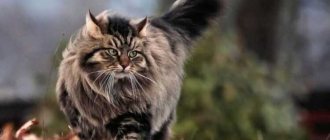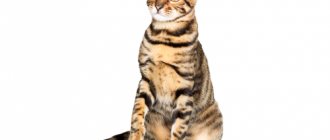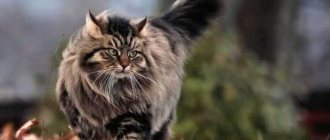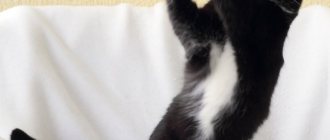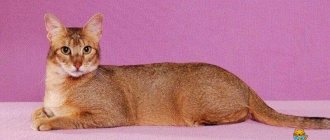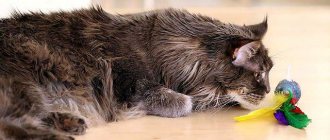Burmese cats are considered not only beautiful and elegant, but also have extraordinary thinking. Such a pet will become a real decoration of the house and the pride of the owners. They are original and intelligent, their short hair is always distinguished by original shades, and their large eyes are simply mesmerizing.
Experts distinguish several branches - American, Australian, European and Asian. They all differ from each other in shades, habits and some other features. Experts note that thanks to its appearance and independence, the Burmese will become a real home guard and the pride of the family.
History of the origin of the Burmese cat breed
The Burmese cat is an ancient breed. The story of its origin began 1000 years ago. The first mention was found in a poem from the 12th century. on the territory of Thailand. In those days, cats often lived with monks. It was believed that cats were possessed by the dead souls of monks who guarded temples.
In 1930, a Siamese cat breeder named Joseph Thompson chose as a gift a purebred Burmese kitten, which was brought straight from the coast of Burma. The kitten was named Wong Mau. Joseph decided to crossbreed him with his Siamese. This is how the ancestors of the modern Burmese cat turned out.
When kittens of this breed were transported to Great Britain, they received the nickname “black Siamese.” They really resemble the Siamese in many ways, but they are distinguished by being more stocky and having a hardy body.
In 1938, chocolate beauties took part in a phenological exhibition for the first time. In 1957, experts formed an official description of the breed and registered it with the Cat Fanciers Association (CFA). The Burmese is becoming a popular breed. Now it is one of the most popular breeds in the USA and Europe.
Interesting!
An interesting fact is that the Burmese shorthair cat served as the basis for breeding the Bombay, Tonkinese, and Burmilla breeds.
American and European Burmese type
The Burmese cat breed is divided into 2 varieties: European and American type. The American type looks more exotic - it is distinguished by a rounded, flattened muzzle, thick skin and dense hair. The American Burmese cat has expressive round eyes. They create a special expression on the face.
The European Burmese cat has an elongated muzzle - the head tends to take the shape of a rounded wedge. The European type of cat differs in the description of its fur; it does not have such gloss and shine. The skin is thinner. The American Burmese cat will always be heavier than the European one. In general, Europeans are more similar to the British.
How to choose a kitten
Burmese kittens are born small in appearance and parameters and look small at 3 months. At first, the babies are all white and the main color will develop when they are one year old.
When choosing, they evaluate the appearance of the kitten; it should not be thin, but active. Examine the eyes, ears, anus. A healthy baby does not have gray-yellow discharge, and the stomach is not swollen and soft.
If possible, examine the cat's mother and the family's habitat.
Before selling kittens, breeders vaccinate kittens according to age, wean them from mother's milk and transfer them to independent feeding.
In the nursery, a complete package of documents with a veterinary passport and a registered pedigree will be prepared for a Burmese kitten. When studying the composition of ancestors, they make sure that there are no hereditary diseases in the line.
Important! It is recommended to buy an elite breed of Burmese kitten from licensed nurseries, which guarantee that the baby will not have hereditary diseases.
Burmese kittens photos
How much does a Burmese kitten cost?
The cost of the Burmese breed depends on the nursery and its pedigree.
- Pet class kittens. Those with deviations from the standard and castrated cost up to 15 tr.
- A breed class pet with a good pedigree for subsequent breeding of offspring costs more, ranging from 15 to 35 thousand rubles.
- Elite show class kittens, future winners of exhibition shows, cost over 35 thousand rubles.
Nurseries
There are not very many nurseries in Russia and neighboring countries. The popularity of the Burmese cat breed in the country is still gaining momentum.
- Moscow, Russia. Cattery "Burma Aldis", Burmese cats.
- Contacts; https://www.burma-aldis.ru/.
- Russia, Moscow. Cattery "O'KLER" Burmese cats.
- Contacts: +7 964 519-0517 [email protected] ://www.okler.ru/
- Saint-Petersburg, Russia. Cattery "Bourimea*RU" Burmese cats. System: FIFe
- Contacts: +7-921-421-79-09; e-mail; https://www.bourimea.ru/
- City: Riga (Latvia). Cattery "LV*Malsan" Burmese cats. System: FIFe.
- Contacts: +371 29127603; e-mail; www.malsan.lv
Appearance of a Burmese cat
The Burmese cat breed is distinguished by its exotic appearance with characteristic features in the structure of the skull and bones. A strict breed standard helps determine the class of a pet. Experienced breeders determine the future winner of exhibitions by appearance alone.
Height and weight
The Burmese cat is compact in size. Height at the withers reaches 22-25 cm. The average weight of a pet is 5-6 kg. Males weigh a little more - 7-9 kg. No matter how much a Burmese cat weighs, its small dimensions are always difficult to compare with its mass.
Interesting!
The breed was nicknamed "bricks wrapped in silk." All due to heavy bones and muscles. This is one of the main features in their description.
Length and shape of limbs
The Burmese cat has the characteristics of a proportional and well-built animal. The limbs are well developed. The paws are quite elegant, but not thin. Fingers fit tightly to each other. The pads on the paws are soft. The medium-length tail is darker in color.
Head
The Burmese cat has its own characteristics, for example, its head is almost perfectly rounded. In profile, a developed stop is noticeable (the transition from the forehead to the nose). The chin is well developed and has a rounded shape.
The medium-sized ears are set far apart and slightly tilted forward. The tip of the ears is rounded, the base is widened. The neck is well developed, short but muscular.
Eye color and shape
The iris is yellow, there are golden and amber eyes. They are set wide apart from each other. The round shape of the eyes makes cats look serious and wise. The outer corner is slightly turned up towards the temples. Eyes tend to change their shade depending on the lighting.
Interesting!
You can better see the shape of the head and the beautiful color of the eyes in the video in the gallery.
Wool
The hairs are short. The fur is sable and shimmers in any light. The fur is thick and quite soft to the touch. There is practically no undercoat. It is enough for the owner to carry out weekly combing with one slicker or brush.
Constitution
Despite its average size, the pet has a strong build and strong bones. They are stocky and hardy, this is the most important characteristic of the Burmese. The figure is athletic, with a pronounced muscular corset. A healthy cat cannot have symptoms of obesity, flabbiness, or flabby muscles. The chest is round and well developed. The back is straight.
Voice
The Burmese cat breed is talkative. They meow loudly and often. Moreover, they only talk so actively with people.
Important!
Reviews note that the Burmese breed is not suitable for those who react sharply to extraneous sounds.
Possible defects
Defects do not allow the cat to participate in exhibitions, and in some cases the animal is not allowed to be bred.
List of common defects:
- in adults - stripes on the body, on the outside of the paws;
- any spots or stripes on the coat;
- color that does not meet standards;
- inappropriate color of nose and paw pads;
- elongated, narrowed muzzle;
- green eyes;
- creases on the tail;
- malocclusion;
- blindness, deafness;
- too little weight.
No matter how many shortcomings an animal has, they do not affect their character. Often, pets with minor defects (for example, a spot on the fur) are sold cheaper. Cats live well with such defects if they do not affect their health.
Interesting Facts
During the existence of the breed, many interesting things have been associated with it:
- Burmese cats have long been deified. In their historical homeland, there is a legend according to which these animals are the reincarnation of the souls of monks.
- Due to their considerable weight and beautiful shiny coat, the Burmese is nicknamed “a brick wrapped in silk.”
- Paintings from the 14th to 18th centuries, which are kept in the Bangkok Museum, depict Burmese cats.
- The name of the breed is often abbreviated. The Burmese cat is called Burmese, Burmese and even Burmese.
Coat color
The Burmese cat is painted in classic colors - sable, champagne, blue, platinum and cream. The upper part of the body has a more intense color; the lower to the paws, the lighter the fur. However, monochromatic colors remain in high esteem, which is becoming increasingly rare.
Sable
The Burmese cat is distinguished by its rich colors. Sable is the most common brown, almost black color. Considered the main one. She is the one shown in the photo. The ears, tail and mask on the face are highlighted in an even darker, almost black color. The pads and nose are dark brown. The eye color is golden, amber.
Champagne
The Burmese or champagne-colored Burmese is a light variation of the sable color. The main shade of the coat is milky, coffee with milk. This color option is interesting to buyers who are looking for a beautiful pet. The muzzle is highlighted with a chocolate-colored “mask”. The tail and paws are painted a darker color. The nose and pads are painted chocolate.
Blue
The Blue Burmese cat has a uniform blue coat. The nose and paw pads are painted blue with a gray tint, which is clearly visible in the photo. The lighter and cooler the shade, the better. The fur shimmers in the same way as the sable color.
Interesting!
Representatives of this color appeared randomly in 1955. The brown Burmese cat carried a recessive gene for blue color, which appeared in several kittens in the litter.
Platinum
This is a light blue color option. The Burmese cat in the photo has a platinum color. The coloring is characterized by light beige fur - the lightest of all available colors. Let's say a slight touch of purple. An even lighter, almost pearly shade is visible on the belly and the end of the paws. The pads on the paws and nose are colored brown-pink or purple.
Cream
In recent years, another color has begun to be distinguished - cream or red. This colorway is very similar to platinum, but the back is painted a deeper shade of orange. Pops of bright colors are reminiscent of the blush on baked goods. The nose and paw pads are pink. The color is in demand among a wide range of buyers and breeders.
The photo below clearly shows the difference between platinum (left) and cream color (right).
Tortoiseshell colors
The Burmese cat comes in a tortoiseshell color. Available in brown, blue, chocolate and lilac tortoiseshell. The color is distinguished by light, brown and red spots, which are evenly scattered throughout the fur. However, there is no drawing. There is no ideal standard for a given color, because... each of them is unique.
Interesting!
It is believed that tortoiseshell colors are found only among European Burmese cats
Characteristics and habits
The Burmese cat breed has a loyal character. Among cats, it is difficult to find a more loyal and playful breed. They become attached to their owner for life and cannot imagine themselves without a two-legged partner.
Attitude towards people, children, other animals
The Burmese cat has a personality that is suitable for large families with children. Pets love to spend time with their family, although at first glance they seem gloomy. They get along well with children and never give up playing.
Burmese people have an extroverted personality. They are very sociable, but can be overly intrusive. The Burmese cat painfully endures separation from its owner. If the owners are constantly missing at work, then the friendly Burmese needs a partner.
The cat is loyal to being around other pets. They live especially well with cats and dogs.
Intelligence
Burma is a stubborn and persistent creature that always achieves its goals. The cat has high intelligence. If desired, the European Burmese can be taught different commands.
The Burmese have a rather clean character. Pets quickly get used to the tray, sleeping and feeding area, removing a whole bunch of problems from the person. They don't sharpen their claws where they shouldn't, provided the room is equipped with a scratching post. With a loving owner, they quickly learn good manners.
Interesting!
Thanks to their developed intelligence, cats easily read the mood of the owner. They will not bother him, but will not refuse to play when the owner is in a good mood.
Lifestyle
The cat is suitable for families who lead an active lifestyle. The Burmese breed is very playful. They retain their playfulness until old age. Cats prefer to sleep alone. Next to the owner, they will attract attention in every possible way. Cats love to be talked to, played with, and petted. Their behavior is more reminiscent of dogs. These are the best hunters and mousecatchers. The videos perfectly convey the behavioral characteristics of the American Burmese.
Owner reviews
Advantages: Affection Disadvantages: they are good, no disadvantages My parents had a lilac cat from the beginning, Izya. He fell in love with my mother and never left her side. When she left on business, he screamed heart-rendingly, cried and suffered under the door. He hated me terribly, I don’t know why, but still. After two years of unpretentious life, he died unexpectedly. Mom was hysterical. But after moving away from the tragedy, I decided to take a Burmese again, but this time chocolate-colored. It was a wonderful, very beautiful cat, Cupcake. But as it turns out, this breed has huge health problems. And after castration at 8 months, Kex became very ill with his stomach. The food was not digested, and there were attacks when the cat fell and suffocated. Doctors gave the cat a maximum lifespan of a week or two. He lay there and died quietly. His mother was hysterical and seemed to die along with him. My heart couldn’t stand it and I came and took him from my mother’s hands and took him to be euthanized. It was very difficult and scary. But this torment had to stop. Now my husband and I gave our mother a Bengal and they are happy. The Burmese is a very good cat, but our experience with this breed was not successful. Buy this breed but only from trusted nurseries. So as not to suffer later. Burmese are affectionate and very attached to people.
Yulia1411
https://otzovik.com/review_777085.html
Burmese cat - Love without borders! Advantages: Endless Disadvantages: The breed is not cheap Let me start with something not very pleasant... I have never liked cats (cunning, fluffy ones...). Everything changed after my mother persuaded me to give her Burma for her birthday!) This is a real cat dog! This is a creature of unreal beauty and unreal devotion! The Burmochka will follow you with its tail, caress, purr, “talk”, will show off its playfulness in front of you, behaves very dignified when going to the doctor, this breed is very talkative, but does not walk and squeal without a reason, such intelligence There is simply no limit to the cats. With such excellent content, this happiness is also beautiful, almost non-shedding, non-smelling, and not picky in food, but you won’t want to skimp on such magic. BUT!!! This breed should not be left alone. The Burma is very vulnerable, touchy, and characteristic. Alone, he will fall into terrible depression. If you spend enough time at home and are ready to spend it communicating and playing with a cat, or you have children, or you are alone and you need the most faithful friend... The Burmese cat is your cat. You will never regret spending money on this full-fledged member seven!
LOMAKINANA
https://otzovik.com/review_3601261.html
Advantages: neat, playful, sociable, beautiful colors, curious, muscular, adapts well to a new place, clean, silky fur Disadvantages: high price, looks funny as a kitten, cannot stand loneliness Luxury and grace. His Majesty Burma! Our pet is an important purebred person. The appearance of a cat is just a calling card. The trick is the incredibly beautiful fur. Smooth short shiny. Very similar to a mink coat. The downside is that all this beauty of the breed appears only when the cat grows up... He looks ridiculous as a kitten. Half-bald, of an incomprehensible color, “little runt.” Regarding character, I think it’s all individual. But if it is useful for someone, I can say a few words about the character of OUR pet: Sociable, playful, cannot stand loneliness; Easily finds a “common language” with guests; Clean (no problems with going to the litter box); Unfortunately, he suffers from the fact that he likes to chew furniture. The breed is quite rare, there are few breeders, so kittens are very expensive today. Conclusion: the breed is very beautiful and unusual. I definitely recommend taking a closer look.
J_u_l_i_a
https://irecommend.ru/content/o-glavnoi-fishke-burmanskikh-koshek
Care and maintenance
Burma does not require any special conditions of detention. Therefore, the pet is suitable for people who are getting a pet for the first time.
Moving into a new home
Upon arrival, the kitten will need a basic set of items:
- Tray. Be sure to mix a little old filler into the fresh filler (a used sample can be taken from the breeder). This way the kitten can easily find the toilet by smell. The dimensions of the tray must correspond to the dimensions of the kitten.
- Bowls. A bowl of clean drinking water and a bowl of dry food should be available at all times. The most hygienic material is ceramics. You will also need a bowl for treats and wet food.
- Carrying. For visits to the veterinarian or moving house, a carrier is required. It must match the size of the pet. The best carriers for the winter are fabric ones with fur inside, and for the summer - plastic ones.
- Scratching post. It is recommended to choose vertical scratching posts with good characteristics (strong frame, well-glued twine, etc.). This way the kitten will feel comfortable sharpening its claws. Without these conditions, the kitten will damage walls and furniture.
- Toys. This is a necessary attribute in a cat's life. It is recommended to give the kitten two toys for 2-3 days, and temporarily hide the rest. This way you can alternate them, again and again arousing the kitten’s interest. The Burmese has a mischievous character and increased activity, so she needs to see different toys.
Important!
So that the kitten experiences less stress when meeting new objects, he is placed in a small room where all his things are placed. A large house is shown 7-10 days after arrival.
Hygiene and medical procedures
Hygiene procedures:
- Combing. It is carried out once a week. Short-haired breeds do not require scrupulous care. During the molting period (spring/autumn), 2 brushings per week will be needed.
- Nail trimming. Manicures are done at least 2 times a month. Otherwise, your pet will grow sharp claws that can easily scratch furniture, upholstery, and textiles. Also, long claws cause physical discomfort to the pet.
- Bathing. Short-haired cats should not be washed more than 1-2 times a year. They are clean and deal with dirt on their own. An exception may be an unforeseen situation in which the pet is very dirty.
- Eyes and ears. The condition of the eyes and ears is checked every week. If there is dirt, wipe it with a damp cotton pad.
Medical procedures:
- Vaccinations. Starting from the age of three months, the kitten must be vaccinated. Further revaccination is carried out once a year.
- From 9-10 months, kittens begin to undergo the procedure of sterilization/castration.
- From the age of 5-7 years, cats are recommended to undergo a full examination on an annual basis, including a cardiac ultrasound. This will make it easy to prevent chronic diseases.
Diet
Each owner chooses what diet his pet will adhere to. There are 2 options - industrial purchased feed or a natural menu.
Among purchased feeds, preference should be given to holistic and premium feeds.
Food for Burmese cats:
- ACANA;
- Grandorf;
- ProNature Holistic;
- Applaws;
- Riverwood;
- Farmina N&D.
Important!
Cats that eat premium food live much longer. They are also protected from problems with digestion, the genitourinary system, etc.
It is recommended not to violate the portion limits indicated on the packaging so as not to harm the health of the pet. The composition contains essential minerals, trace elements and vitamins.
Other owners choose a natural menu. Here you need to independently measure the components and calculate the proportions.
Natural diet:
- 80% of the diet is natural meat, always lean. It could be chicken, turkey, rabbit, veal, beef. It is acceptable to give lean fish.
- 1-2 times a week the pet is treated to kefir or low-fat cottage cheese. Sometimes you can give your cat low-fat sour cream.
- Give boiled eggs 1-2 times a week.
- The bowl must contain vegetables, which will become an additional source of vitamins. Cats love carrots, zucchini, and greens.
- Includes boiled cereals - millet, oats, buckwheat, pearl barley.
- A vitamin complex must be added to the natural menu.
Keeping Burmese at home
Interesting to know! It is believed, according to ancient beliefs, that Burmese cats bring good luck to the house. That is why they were kept in temples, as well as in the abodes of rich people, who believed that these cats contributed to the appearance of wealth, prosperity and family happiness in their home.
In fact, such legends have nothing to do with the behavior of this cat, since they themselves represent an ideal animal for keeping at home. These are friendly and fairly clean pets. At the same time, they have a hard time experiencing long-term separation, remaining alone, and this factor must be taken into account.
Due to the fact that Burmese cats are quite curious by nature, it is necessary to ensure that they do not have access to various things and household items, especially at a young age. The same applies to household chemicals that cats can taste.
It is not recommended to let this cat go for a walk on its own. It is very important that she is on a leash. You can let her out at your dacha, but it is better to always remember that the cat is vaccinated and also take care of other means of protection, such as a flea collar, for example.
Care and hygiene
These cats do not require special care, especially since they have short hair without undercoat. The coat is combed once every 2 weeks and this is quite enough. You should also not bathe your animal frequently. It is enough to organize water procedures a couple of times a year.
As a rule, they tolerate water procedures without problems, since they completely trust their owner. The eyes and ears of your pet should be cleaned once a month, and the nails should be shortened once every 2 months.
What to feed
When feeding ready-made dry factory mixtures, preference should be given to premium or super-premium food. This is necessary to ensure that the cat receives all the necessary nutritional components, which is so important for the health of a domestic cat. When feeding kittens, care must be taken to include low-fat boiled fish in their diet. To effectively fight tartar, you need to make sure that dry food is present in your diet.
It is better to give older cats natural food, including rabbit meat, chicken or beef, but in the form of minced meat, since old animals have great difficulty chewing solid food. Pregnant or lactating cats require increased nutrition. To do this, it is enough to increase the daily ration or use special purchased feed. Nowadays, you can buy any food for animals in specialized stores.
Important to remember! Your pet should not be allowed to overeat. These are large animals with a good appetite that can eat more food than they should. In this regard, it should be noted that this breed is prone to gaining excess weight, and this can lead to health problems.
Under no circumstances should cats be given food from the human table. People tend to eat salty, spicy or sweet foods, which are harmful to pets, including cats, regardless of breed.
5 features of keeping a Burmese
Diseases, breed defects
These cats are susceptible to extremely unpleasant diseases, and this is true both in relation to the European Burmese cat and in relation to the American one. This is one of the negative factors that scares away many who want to have a Burmese cat at home. Therefore, when choosing a kitten, it is very important not to make a mistake.
Gangliosidosis is considered one of the most common hereditary diseases of the nervous system. The disease begins to manifest itself from an early age in the form of lameness and paralysis. As a rule, the pet dies because this disease cannot be treated, despite the enormous efforts of modern scientists who are trying to solve this problem.
Hypokalemia, which is associated with a lack of potassium in the animal’s body. A deficiency of this component leads to increased fatigue, as well as general lethargy. The disease can be treated by administering drugs containing potassium ions. Otherwise, the process worsens and paralysis of the animal occurs.
Burmese cats may develop flat chest syndrome, which can be detected in the first days of a kitten's life. This disease is associated with imbalance of the chest muscles, which leads to disability of the animal. There is no effective treatment for this disease, although some kittens manage to survive this disease, after which everything returns to normal.
The eyes, ears and mouth are also considered areas that are prone to various abnormalities. In any case, you should seek help from a veterinarian, since only specialists can prescribe the correct treatment.
Important point! Veterinarians have all the necessary information, as well as medications that will help solve various health problems for pets.
Hereditary diseases
In general, the Burmese cat is in excellent health. But there are a number of problems that their owners may encounter.
Gum inflammation
The Burmese cat inherited the disease from its Siamese ancestor. Inflammation of the gums provokes loosening and loss of teeth, causing discomfort to the pet.
The disease is caused by bacteria in the oral cavity. It is for this reason that animals are recommended to brush their teeth at least once a week.
Symptoms of gum problems:
- unpleasant odor from the mouth;
- red and inflamed gums;
- pet's refusal to eat.
Hypokalemia
The disease is associated with a lack of potassium ions in the blood. Due to potassium deficiencies, muscle weakness may develop. Sometimes it gets to such an extent that the animal cannot even get up. The Burmese cat breed transmits the disease by inheritance; the exact cause of hypokalemia is unknown. The disease manifests itself in kittens aged 2-6 months.
Symptoms:
- muscle weakness (the pet is not even able to hold its head in a stable position);
- lack of appetite;
- labored breathing.
In the early stages of the disease, the characteristics of general health are stable. As a treatment, Burmese are prescribed lifelong support with potassium supplements.
Problems with tearing
The eyes of Burmese cats are often wet due to increased lacrimation. The reason for this is the unusual shape of the muzzle. To help the pet, the owner must carry out hygiene procedures daily and clean the corners of the eyes. This feature is not a disease.
Breed defects
Burmese are distinguished by good health and have good immunity. However, a tendency to certain diseases is still present.
Common Breed Diseases
Among the most popular diseases for Burmese are the following:
- gingivitis (gum inflammation);
- deformation of the skull (congenital);
- increased lacrimation;
- labored breathing.
Regular visits to the veterinarian, timely vaccination and deworming will help you avoid health problems for your pet. As a preventive measure and to get rid of worms, the cat is given anthelmintic drugs at least once every six months and always two weeks before vaccination.
Once a year, the cat is given an antiviral vaccination and once a year a rabies vaccination. Before vaccination, a doctor's examination is required, since vaccination is carried out on a healthy animal.
Defects in appearance
Breed standards do not allow Burmese cats with the following defects to qualify:
- Broken or abnormal tail, medallions or spots.
- Blue eyes. Strabismus. Incorrect color of nose or paw pads.
- Malocclusion leading to severe overbite or underbite, which visually violates the profile described in the standard.
- Improper jaw formation, resulting in protruding, protruding teeth or a distorted face or jaw.
- Pronounced stripes along the body. Any color that differs from the acceptable ones.
Choosing a kitten, cost
The Burmese cat constantly collects positive reviews, which attracts the attention of buyers. However, you need to buy a pet only in a specialized nursery, or from a trusted breeder. Choosing the right animal is the key to its future health. Kittens are handed over at the age of 3-4 months. The appearance of the kitten plays an important role.
Signs of a healthy litter:
- clean wool without bald spots;
- no discharge from the eyes or nose;
- clean ears;
- playful and curious mood.
Starting price in Moscow – 20 thousand rubles. A show-class kitten costs 40-60 thousand rubles. Kittens without a pedigree can be sold for 10-15 thousand rubles. However, no matter how much a pet costs, its character and behavior are always impeccable.
Application
An animal, like a munchkin , is ideal for communicating with children.
You can read about other cat breeds that are distinguished by their kindness and friendliness in the article
Unlike other cat breeds, it will never show aggression or fight back, even if the baby picks it up by the tail.
So for children the Burmese will become a loyal friend, ready to play for hours.
She prefers constant communication, which can sometimes even tire tired adults, but not children.
The Burmese cat will demand maximum attention from you. It’s good if there are children in the house who can entertain the pet
Burmese cats can easily get along with other pets.
But it is worth remembering that, although the character of this cat is akin to wool and truly “silk”, it is characterized by the habits of a leader and a strong will.
She will inevitably “conquer” both the territory and the love of all family members.
Breeding the Burmese cat
The best Burmese cats for breeding are healthy individuals from 1 year old. The first heat in cats begins at the age of 6-7 months, but their body is not yet ready to bear kittens. It is recommended to have offspring no earlier than 1 year. A Burmese cat is ready for mating at the age of 10-11 months. For breeding, pets with official documents and pedigree are used.
The best kittens are born from two purebred parents. Pregnancy lasts 70-72 days. Childbirth is quite difficult, it is better to take care of the place of birth in advance and agree with the veterinarian.
The small weight of females greatly complicates the birth process. Typically, a Burmese cat gives birth to 5-6 kittens. No matter how many kittens are born, the mother cat always watches the offspring with special care. During the first few days, a person may not be allowed near the kittens.
Interesting!
At the end of the 20th century, a Burmese cat gave birth to 19 kittens in England, which became a record.
Pros and cons of the breed
The Burmese cat has a breed description that combines both pros and cons.
Pros:
- exotic appearance;
- absence of congenital diseases;
- affection and friendliness;
- loyal attitude towards children;
- developed intelligence.
Minuses:
- talkativeness;
- the Burmese cat has an impressive weight;
- constant need for warmth, the Burmese does not tolerate cold;
- excessive trustfulness even towards strangers and animals;
- high cost of a kitten.
Despite all the pros and cons, owners always leave positive reviews about the breed. The Burmese cat or Burmese manages to find an approach to each family member; it takes into account the character and needs of the owner.
Education and training
Burmese cats are easy to train - they can even follow simple commands. In any case, it is necessary to train a kitten from an early age to achieve the best training. It is also advisable to consult with experts in this matter, who will help you choose the most suitable training exercises or appropriate training programs.
Cats of this breed are quite amenable to training, are not aggressive and respond appropriately to comments, which makes Burmans good students.
Photo and video
Photos of adults and kittens:
Video:
Video: Burmese cat 101kote.Ru burmese 101cats
Video: Burmese cat all about the breed. Interesting Facts
Video: Burmese kitten - features of education
The Burmese shorthair cat is a wonderful pet. These are very sociable, kind and playful creatures that do not require careful care. Be sure to leave personal reviews if you have ever had contact with a Burmese, or you are the owner of one.
Diseases and treatment
The most common diseases for this breed are problems with teeth (gingivitis) and breathing. In the first case, to prevent complications, it is necessary to visit the veterinarian every year for a dental examination. Breathing difficulties in the Burmese cat are caused by the structure of the shortened nose. This is simply a feature of the breed, which cannot be completely eliminated, but it is still important to contact a veterinarian on time.
The average lifespan of this breed is 13-15 years; with constant and excellent care from the owners, they can become long-lived (17-18 years).

